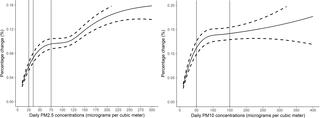Our official English website, www.x-mol.net, welcomes your feedback! (Note: you will need to create a separate account there.)
Ambient particulate matter pollution and adult hospital admissions for pneumonia in urban China: A national time series analysis for 2014 through 2017.
PLOS Medicine ( IF 15.8 ) Pub Date : 2019-12-31 , DOI: 10.1371/journal.pmed.1003010 Yaohua Tian 1, 2, 3 , Hui Liu 3, 4 , Yiqun Wu 3 , Yaqin Si 5 , Man Li 3 , Yao Wu 3 , Xiaowen Wang 3 , Mengying Wang 3 , Libo Chen 5 , Chen Wei 5 , Tao Wu 3 , Pei Gao 3, 6 , Yonghua Hu 3, 4
PLOS Medicine ( IF 15.8 ) Pub Date : 2019-12-31 , DOI: 10.1371/journal.pmed.1003010 Yaohua Tian 1, 2, 3 , Hui Liu 3, 4 , Yiqun Wu 3 , Yaqin Si 5 , Man Li 3 , Yao Wu 3 , Xiaowen Wang 3 , Mengying Wang 3 , Libo Chen 5 , Chen Wei 5 , Tao Wu 3 , Pei Gao 3, 6 , Yonghua Hu 3, 4
Affiliation

|
BACKGROUND
The effects of ambient particulate matter (PM) pollution on pneumonia in adults are inconclusive, and few scientific data on a national scale have been generated in low- or middle-income countries, despite their much higher PM concentrations. We aimed to examine the association between PM levels and hospital admissions for pneumonia in Chinese adults.
METHODS AND FINDINGS
A nationwide time series study was conducted in China between 2014 and 2017. Information on daily hospital admissions for pneumonia for 2014-2017 was collected from the database of Urban Employee Basic Medical Insurance (UEBMI), which covers 282.93 million adults. Associations of PM concentrations and hospital admissions for pneumonia were estimated for each city using a quasi-Poisson regression model controlling for time trend, temperature, relative humidity, day of the week, and public holiday and then pooled by random-effects meta-analysis. Meta-regression models were used to investigate potential effect modifiers, including cities' annual-average air pollutants concentrations, temperature, relative humidity, gross domestic product (GDP) per capita, and coverage rates by the UEBMI. More than 4.2 million pneumonia admissions were identified in 184 Chinese cities during the study period. Short-term elevations in PM concentrations were associated with increased pneumonia admissions. At the national level, a 10-μg/m3 increase in 3-day moving average (lag 0-2) concentrations of PM2.5 (PM ≤2.5 μm in aerodynamic diameter) and PM10 (PM ≤10 μm in aerodynamic diameter) was associated with 0.31% (95% confidence interval [CI] 0.15%-0.46%, P < 0.001) and 0.19% (0.11%-0.30%, P < 0.001) increases in hospital admissions for pneumonia, respectively. The effects of PM10 were stronger in cities with higher temperatures (percentage increase, 0.031%; 95% CI 0.003%-0.058%; P = 0.026) and relative humidity (percentage increase, 0.011%; 95% CI 0%-0.022%; P = 0.045), as well as in the elderly (percentage increase, 0.10% [95% CI 0.02%-0.19%] for people aged 18-64 years versus 0.32% [95% CI 0.22%-0.39%] for people aged ≥75 years; P < 0.001). The main limitation of the present study was the unavailability of data on individual exposure to PM pollution.
CONCLUSIONS
Our findings suggest that there are significant short-term associations between ambient PM levels and increased hospital admissions for pneumonia in Chinese adults. These findings support the rationale that further limiting PM concentrations in China may be an effective strategy to reduce pneumonia-related hospital admissions.
更新日期:2020-01-14


























 京公网安备 11010802027423号
京公网安备 11010802027423号